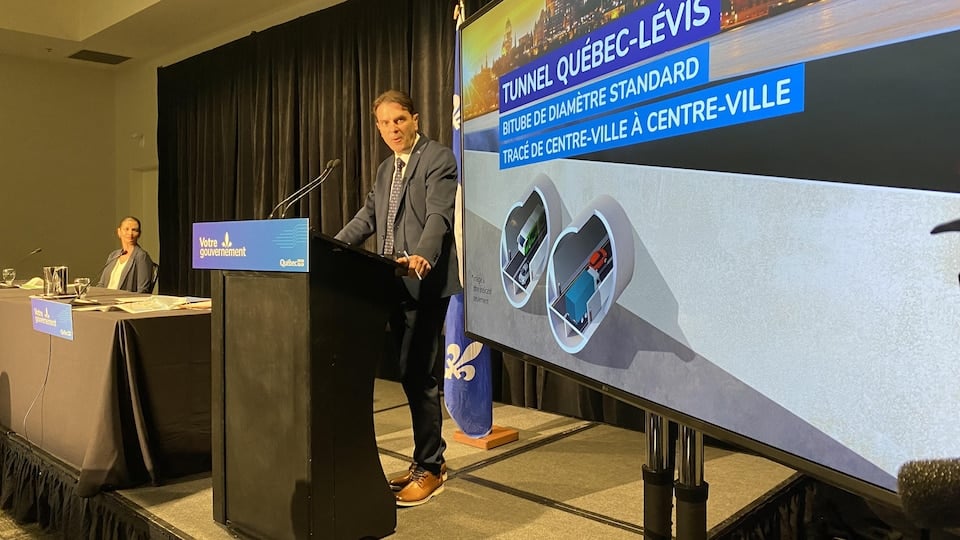The Ministère des Transports du Québec (MTQ) confirms that this portion of the envelope, called related costs
includes several elements: reserves for risk management, inflation costs, financing costs, salary costs, etc.
This range of 10% to 35% is the same as for the first version of the project. However, since the related costs are now included in a more modest envelope, the amount available for contingencies has also been reduced.
In order not to interfere with the tendering process, the ministry never reveals the details of its estimates.
however, indicates by email the spokesman of the MTQ, Bryan Gelinas. Impossible, therefore, to know how much are estimated only the possible cost overruns or the sums reserved to take inflation into account, for example.
During his press conference, however, Minister Bonnardel affirmed that the risk surrounding the new two-tunnel project had been “well assessed” and that it was lower than during the first draft.
The upper limit of 35% for ancillary costs nevertheless seems Quite small
in the eyes of engineer Bruno Massicotte, professor in the Department of Civil, Geological and Mining Engineering at Polytechnique Montréal.
Having himself carried out a study in 2016 for a tunnel between Quebec and Lévis which was to pass through the western tip of Île d’Orléans, the expert recalls that the less advanced a project is, the greater the uncertainty on the financial plan.
The estimated $6.5 billion appears to him as a floor price
he admits.
” For this to be possible, the preliminary work, the drilling work and all that must be at a very advanced stage, perhaps more advanced than the information that has been publicly transmitted. »
Several unknown elements
The third link, which is in the draft phase, still contains many unknown elements. For example, the diameter of the two tunnels now planned by the MTQ is not yet confirmed.
It is now a question of a width oscillating between 12 and 15 meters. However, between these two dimensions, there could be a difference of about 30% on the final cost of the work, according to Professor Massicotte.
In addition, soil characterization, which began in 2019, is not complete. Deepwater marine drilling will not begin until this summer.
The nature of the soil is however the greatest source of cost variation in a tunnel project, according to Professor Massicotte, because of all the surprises that can arise during excavation.
He also specifies that the ground is not the same all along the 8.3 kilometer route planned for the third link. He also recalls that experts fear the presence of a deep canyon in the basement of the river.
” The nature of the ground changes a lot along the route. It affects the choice of tunnel boring machine and it also leads to construction methods that are different from one place to another. »
All of this leads Professor Massicotte to say that it is only when the calls for tenders come up, in a few years, that we will be able to have a really clear idea of the real costs associated with the construction of the third link, including the delivery is scheduled for 2032.
View data
This is also the opinion of Jean-Philippe Meloche, professor at the School of Urban Planning and Landscape Architecture at the University of Montreal. It remains very rough as an estimate
he says about the envelope of 6.5 billion dollars.
In 2032, we will no longer be talking with the same dollars. We will no longer speak with the same discount rates. We will not talk about today’s conditions. So it’s very likely that the bill we’re going to pay in 2032 won’t be the[s] $6.5 billion
he says.
” It is quite possible that when the calls for tenders come up, we will realize that there is no company in the world that is capable of doing that within the designated envelope. »
Professor Meloche also wonders on what data the MTQ relies to justify a project of such magnitude. I think it would be very reassuring for the Ministry of Transport to reveal the studies that show us that we have benefits of up to $6.5 billion
he says.
On this point, the MTQ maintains that many analyzes have been carried out in this direction as part of the opportunity study [et que] these analyzes will be compiled and made public no later than the adoption of the business case
.
During his press conference, Minister Bonnardel mentioned the year 2025 for the filing of this business file.
Reference-ici.radio-canada.ca

